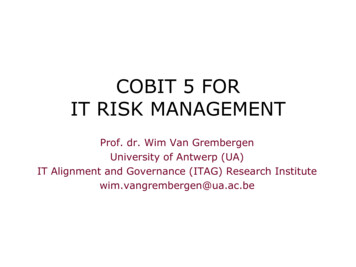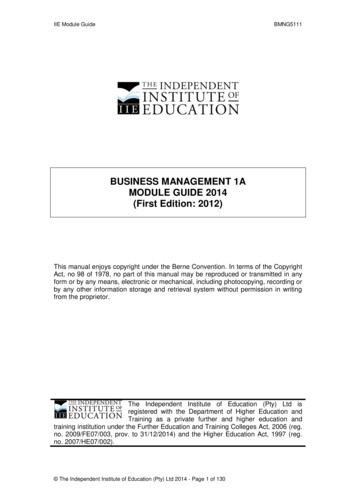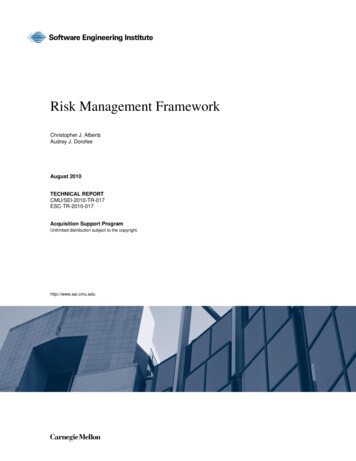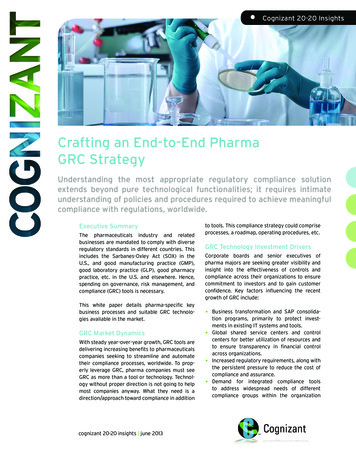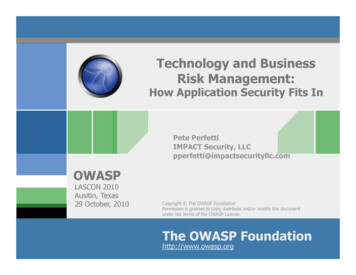
Transcription
Technology and BusinessRisk Management:How Application Security Fits InPete PerfettiIMPACT Security, LLCpperfetti@impactsecurityllc.comOWASPLASCON 2010Ausitin, Texas29 October, 2010Copyright The OWASP FoundationPermission is granted to copy, distribute and/or modify this documentunder the terms of the OWASP License.The OWASP Foundationhttp://www.owasp.org
Presenter’s Background Former head of IT Security and Risk Management at global financial andentertainment companies. "The Visible Ops Handbook - Starting ITIL in 4 Practical Steps" – Work atViacom and MTV was one of the case studies on how to successfullyachieve a high performing IT organization. “The Visible Ops Security Handbook – Achieving Common Security and ITOperations Objectives in 4 Practical Steps” – Contributor, wrote end ofchapter summaries for each section of the book. “Change, Configuration, and Release Performance Study” – IT ProcessInstitute “Top Performer Roundtable to focus on Change Configuration and Releasepractices that drive highest levels of performance” – IT Process Institute Emerging Trends in Enterprise Security - “Corporate Challenge:INFORMATION SECURITY@RISK: ARE YOU ON THE RISK MANAGEMENTTRACK?” - Technology Managers Forum Former OWASP Chapter Leader: NY/NJ Metro ChapterOWASP2
Current Activities IMPACT Security, LLC Cyber Security Consulting & Professional Services Firm Vulnerability & Risk Assessments; Penetration Testing Developing and/or Enhancing Information Security & RiskManagement Programs Incident Response, Prevention, and Recovery Audits, Compliance Checks (SOX, PCI, etc.) Tactical and Strategic Cyber Security Projects Security, Audit, and Risk Management Training Remediation, Implementation Dallas, Texas; and NYC Metro Area Financial, Entertainment, Media, Sports, Publishing, Pharmaceutical, Oil &Gas, Aerospace, Government, Academic, Retail, Individuals OWASP Project – CISO Application Security ChecklistOWASP3
Information Security OfficerandRisk Manager concerns.OWASP4
Primary Types of Risk Concerns and theirBusiness Impact Operational – Adverse affects on the operational stability of theorganization’s technology infrastructure that compromises theconfidentiality, integrity, and availability of data and services. Financial – Direct financial loss to the business. Reputational – Harm done to a company that may not bereversible, and may cause direct or indirect negative financialimpact. Legal – Issues that cause criminal or civil legal problems for theorganization, or that force compliance with laws and court ordereddirectives. This type of risk can often lead to other types of risks. Strategic – Issues that put the firm on a course for future legal,financial, reputational, operational risk.OWASP5
How does this affect applications?OWASP6
Survey of Risk Managers What are your three primary risk concernsregarding applications and what is the impact ofthese application risks on your business?OWASP7
Survey of Risk Managers What are your three primary risk concernsregarding applications and what is the impact ofthese application risks on your business? What are your top three issues or concerns foroverall audit and compliance?OWASP8
Survey of Risk Managers What are your three primary risk concernsregarding applications and what is the impact ofthese application risks on your business? What are your top three issues or concerns foroverall audit and compliance? Top risk concerns for application security werealmost identical to those for overall audit andcompliance and meeting business riskobjectives.OWASP9
Primary Risk Concerns RegardingApplications and Risk to Business Top risk concerns for application security were almostidentical to those for audit and compliance.Effective and Efficient Change Control.Appropriate and Effective Access ControlLack of a comprehensive Risk Assessment processAdherence to the SDLCHow an application affects other areas of the business, & are theother business areas consulted in the design & development ofnew code, and involved in testing and approvals. Failure to assess risks to third party or purchased applications,their connectivity, understanding how the application will workwithin the existing security systems & compliance requirements. Up to date policies and documentation that appropriately definerisk tolerance. OWASP10
Effective and Efficient Change Control Impact of changes, including patches, to the applicationson stability and security not understood or documented. Process is too complex and not auditable. Lack of effective enforcement of Change Control policyand process. No effective way to measure change. Has something changed?Was the change authorized and scheduled?Number of successful vs. unsuccessful changes.Is the change compliant with policy?Were all approvals obtained?OWASP11
Appropriate and Effective Access Control Approvers don’t fully understand the business processesand the objects they are approving access to. Inadequate User Access Rights Reviews. Inadequate or undocumented data classification. Access to data is not controlled or monitored.OWASP12
Lack of a Comprehensive Risk AssessmentProcess and Adherence to the SDLC Lack of stability from non-adherence to the SDLC Lack of a documented development process withadequate security and risk assessments included whichleads to, or is a product of: Poor security designSegregation of Duties issuesInappropriate access to privileged functions and sensitive dataInadequate testing and approval by the business Failure to correct security issues prior to moving codefrom one stage to another. Lack of, or failure to adhere to, a formal developmentframework and set of processes.OWASP13
Checklist: Considerations for ApplicationDevelopment Issues with new in-house application development: How does the application affect other areas of the business? Are all areas of the business considered in the design anddevelopment of the new code? Are the other business areas involved in testing and approvals?(Extends to the Change Management process) Does the process adequately consider and assess risk prior todevelopment? Is sufficient consideration to integration with the rest oftechnology infrastructure sufficiently undertaken? Is there a failure to correct the stability, security, and risk issuesprior to code release, implementation, and other changes? Are all policies, standards, and processes up to date and is theapplication compliant?OWASP14
Checklist: Considerations for ApplicationAcquisition For applications purchased from a third party: Is consideration given to how the application will work within thecurrent security architecture? Has a security and risk review been conducted on the workflow? Will the new application add new entry points? Does it meet requirements for authentication, access control,and other policies and standards? Will the application only read data, or will it write it? What is the classification of that data? Who needs to access the data? What is the authentication mechanism? How will we perform audits, assessments, and monitoring toprove compliance and maintain business and risk objectives ?OWASP15
Obstacles to Audit, Compliance,and Application SecurityOWASP16
Obstacles to Effective Audit and Compliancein Application Security Resistance to correcting the root causes that cancels outefficiency and cost effectiveness, and increases risk.Audit findings are frequently repeated unnecessarily. telnet, ftp, sql injection, etc., are all still with us. IT is, or will be, caught in the audit-to-audit cycle andpossibly the break/fix cycle as well. Lack of communication & interaction, or there is rivalrybetween different groups within IT which negativelyaffects risk and the business. Failure to understand risk causes Management, IT, andAudit to make erroneous decisions. Failure to assign owners to applications and issues, andfor those owners to responsibly address all findings.OWASP17
Obstacles to Effective Audit and Compliancein Application Security Auditors are perceived as adversaries – ISO/RMs andother security folks are to a lesser extent. Resources are strained gathering data and responding tofindings – An audit adds to support and dev issues: It’s a big distraction from the daily routine. But the break/fix cycle is also a big distraction Always seem to be finishing one audit - or not - whenthe next one starts. Because: The root causes are not being addressed, and; The process for correcting them is not efficient or effective. Not all companies have standards for responding to auditfindings and closing them out.OWASP18
Obstacles to Effective Audit and Compliancein Application Security Inadequate functionality and processes built into theapplication cause many findings, such as monitoring,auditing, logging, access control, SoD, etc. Rush to implement without considering the security andrisk implications, and the compliance requirements. Inadequate, infrequent, and inconsistent security andrisk reviews and failure to correct security and risk issuesprior to implementation or deployment. Policy Issues Policies are not in tune with regulatory and legal obligations. Staff are not aware of, or are just disregarding, policies. Policies do not accurately reflect Mgt’s Actual Risk Tolerance.OWASP19
How do these problems arise?OWASP20
How the Problems Arise Many times concerns are focused on immediate issues: SLA - Deadlines that have to be met General support issues, e.g. firefighting, break-fix cycle Unresolved and repeat audit findings still exist You cannot maintain control if you don’t know andunderstand what’s going on. The same problems are always with us because we havelost situational awareness and control. You lack the will to resolve the issues at the root cause.OWASP21
Situational AwarenessMovie TimeOWASP22
Situational AwarenessOur concern is how many times the team in whitepasses the ball.OWASP23
How many times does your team pass theball?OWASP24
How many times did the gorilla beat his chest?OWASP25
So how did you miss this?OWASP26
If you didn’t see the gorilla 75% of people don’t see it. You were too focused on your individual taskthat you failed to see the anomaly. Others were too focused on what they were toldto do, and they also missed it. You also missed what the other team was doing.OWASP27
For the people who saw the gorilla Do you know how many times the gorillaactually beat his chest? Do you know how many times the team youwere supposed to watch actually did pass theball? How many times did the other team pass theball?OWASP28
Movie EncoreOWASP29
How many times does the team in whitepass the ball?OWASP30
Specifics ofHow We LoseSituational Awarenessin TechnologyOWASP31
Examples of Poor Situational Awareness andLoss of Control Change Management - Little to no effective ChangeManagement. Process is too complex or too difficult to follow so it is bypassed.Micromanaged approvals stifle efficiency and effectiveness.No ability to effectively audit or report on important metrics.Changes to infrastructure can not be made without major risk tostability (The infrastructure is too fragile).OWASP32
Examples of Poor Situational Awareness andLoss of Control Access Control - You don’t know who has access todata. There is little or no classification of data, no documentedowners, nor are there reviews of user access. Approvers have no understanding of what they are approvingaccess to or for.OWASP33
Examples of Poor Situational Awareness andLoss of Control Adherence to the SDLC - The risk assessment processdoes not exist or is not enforced. Application risks are not understood by Management, BusinessOwners, or Developers. Applications are not adequately addressing risk in Policies,Standards, and Processes. Risk assessments are expected to be conducted immediatelyprior to production release leaving no time to correct any issues. Risks are not reviewed prior to development or acquisition andare discovered after implementation.OWASP34
Examples of Poor Situational Awareness Documentation - Risk Tolerance as documented inpolicy does not match the risk that top levelmanagement is willing to take. Missing or outdated versions of policies, processes, guidelines,standards. Little or uneven enforcement of policies, standards, processes. Monitoring and auditing is not defined adequately.OWASP35
Examples of Poor Situational Awareness Monitoring - No relevant monitoring or centralizedreview. Monitoring the wrong data for your environment. Bad things are happening and no one understands why. You don’t know if bad things are happening.OWASP36
How to fix things.OWASP37
Breaking the Audit and Compliance Cycle NECESSITY Accept and understand that these things are necessary. Don’ttolerate excuses for not getting things accomplished. Findsolutions to the root causes. ALLIANCE Make Internal Audit and Security/Risk Mgt. your allies not youradversaries. Work as a team to resolve and reduce findings thatthe external auditors and regulators might discover. DOCUMENTATION Ensure that your policies, procedures, and standards areaccurate and appropriate, and that your risk tolerance isproperly defined in policy. Understand the business objectivesand legal obligations when reviewing, updating, or creating yourpolicies.OWASP38
Breaking the Audit and Compliance Cycle DESIGN Ensure audit & compliance are built-in to your applications,databases, systems, and acquisition. ROUTINE To improve efficiency, cost effectiveness, reduce aggravationand free up resources, auditing and compliance testing shouldbe just like pushing a button to get the data you need. Makeeverything routine. BUSINESS CASE Define your arguments around business needs and managingbusiness risk for
"The Visible Ops Handbook - Starting ITIL in 4 Practical Steps" – Work at Viacom and MTV was one of the case studies on how to successfully achieve a high performing IT organization. “The Visible Ops Security Handbook – Achieving Common Security and IT Operations Objectives in 4 Practical Steps” – Contributor, wrote end of chapter summaries for each section of the book. “Change .





